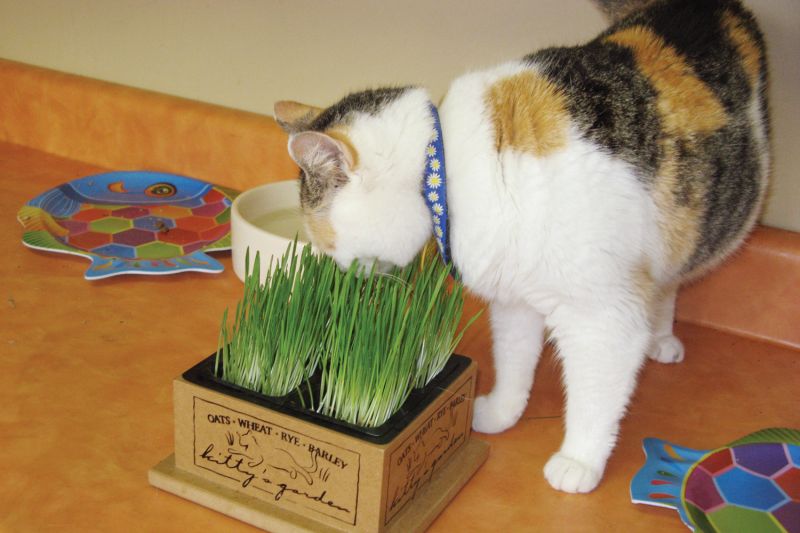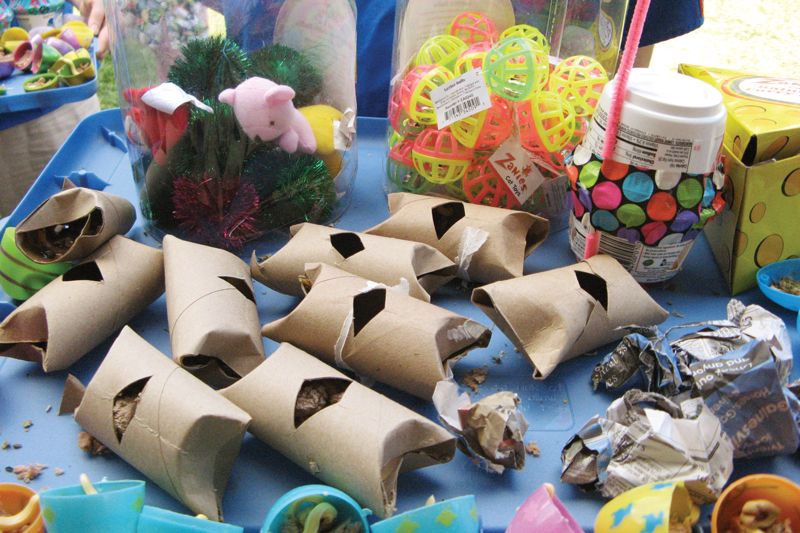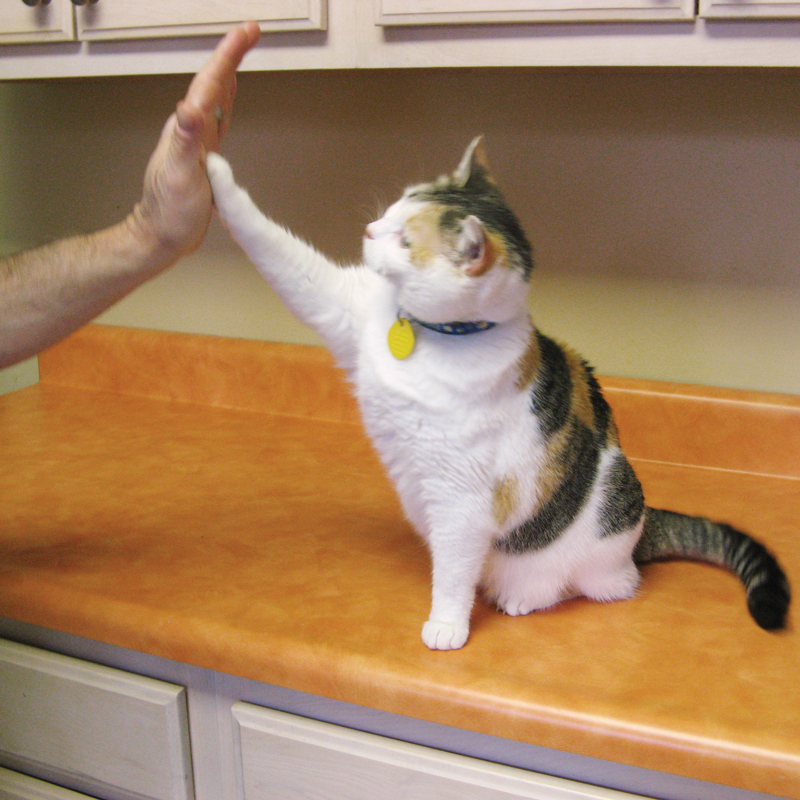Making the shelter a happier place for animals
Practical tips on how to help the animals in your care feel good

We all want the animals in our care to be as healthy and happy as possible. To accomplish this, we must attend to both their physical and emotional needs. We protect the animals’ physical health through routine vaccination, parasite control, proper nutrition, spay/neuter and other basic medical care. We create a healthy environment for them—one that is clean and well-maintained, not crowded, kept at a comfortable temperature and with good air quality.
But how can we protect the animals’ emotional health? What are the practical components of an emotional wellness program for shelter animals?
Picture yourself far away from home, from all the things you know—deposited for unknown reasons in a strange, confining place where you don’t know anyone. What would help you cope?
You’d probably want people to be nice to you. You’d want to know what to expect, so you could adjust to the daily routine. You would want something to look forward to every day. If unpleasant things occurred in the daily routine, you would want to be able to shield yourself from them, and you would want to know when they were going to happen so you could prepare yourself, and then breathe a sigh of relief and relax afterward. You would want a comfortable space with some “creature comforts”—something familiar, something tasty, something cozy, something pleasant to look at, something nice to smell and something soothing to listen to. And it would be great to get a break each day where you could get out for a little play or quiet time, and maybe spend time with someone nice.
The Power of Prevention
We can provide for the emotional needs of the animals in our care and help them cope with shelter life. An emotional wellness program starts with proactive strategies to decrease stress, fear and negative experiences while promoting comfort and providing regular, positive, predictable experiences throughout an animal’s stay. Providing animals with comfortable housing, gentle handling, consistent daily routines and regularly scheduled play and exercise, mental stimulation and social companionship is crucial.

Simple, consistent positive-reinforcement-based training will also go a long way toward ensuring animals feel good during their stay. Animals need to be able to do the things cats and dogs enjoy doing; they need outlets to express their normal behaviors. Most of all, they need to know how to interact and build a trusting relationship with their caregivers, because reliable, positive social connections with us are essential for their well-being.
Obtaining a history and evaluating animals at intake helps us adapt our protocols to meet the needs of individual animals. It may not be possible to obtain an accurate history on all animals at intake, but we should aim to get as much health and behavior background as possible. Assessing an animal’s level of fear and her initial response to gentle handling will also provide important insight into her needs in the shelter environment.
At a minimum, housing must include a comfortable resting place, ensure freedom from fear and distress and allow animals to engage in normal behaviors. What’s “normal” will be different for different animals, based on their species, size, personality and individual preferences. Soft bedding should be available, both for physical comfort and so that animals can establish a familiar scent, which will help them acclimate. As much as possible, animals should remain in the same enclosure—moving to a new place is always stressful! Keeping their bedding with them throughout their stay and only laundering it when it’s soiled will help.
Reducing Fear Factors
The power of gentle, thoughtful handling and the regular provision of creature comforts cannot be overemphasized. Help cats to feel safe by transporting them in covered carriers so that they are not exposed. Avoid placing cat carriers on the floor, where cats may feel vulnerable or threatened. Instead, place them on a counter—cats will feel more secure perched at a safe vantage point. For dogs who do not walk willingly on a leash, coax them with a treat, provide a mat to walk on if they are afraid of slippery flooring or gently carry them if necessary. Always keep cats and dogs separated, and minimize barking and other loud noises.
Whenever possible, cats and dogs who exhibit marked fear at the time of entry should be housed in specially designated quiet areas. All cats and kittens, regardless of their demeanor, should be provided with a hiding box in their enclosure at the time of entry; the ability to hide reduces fear and stress, and helps them cope while acclimating to their new environment. For cats who are severely stressed or reactive, covering the cage front and posting signage to allow the cat time to calm down or “chill out” for several hours or even a few days can also facilitate adaptation to their new environment.
Likewise, fearful dogs and “nervous little dogs” such as toy breeds will benefit from being housed in a quiet ward away from the holding kennel—or in the quietest area within the kennel. Using a shower curtain to cover the kennel front will shield them until they have time to acclimate. When they are more comfortable, begin to open the curtain so they can see out. Installation of such temporary visual barriers often calms reactive barking and helps keep the kennel quieter and less stressful for all. Minimizing foot traffic in these areas is essential—it can be frightening to animals when strangers constantly pass by, especially in the initial days of confinement before they have a chance to get their bearings.
Shielding animals from “scary” experiences is crucial to helping them relax. Cleaning routines are often scary times for many animals. Cats can be allowed to hide in boxes while their cage is quietly tidied and food and water bowls replenished. Dogs in double-sided runs can be provided with tasty treats to occupy them on one side, while the guillotine door is closed for cleaning on the other.

Consistency: A Key to Well-Being
Animals will acclimate to a new environment much more quickly if they sense a routine—if they know who will be caring for them and when, and start to see that the experience will be a positive one.
Seeing familiar caregivers walking through the shelter at regularly scheduled times to hand out treats and toys will send a powerful message to the animals. Knowing when both pleasant and not-so-pleasant things are going to happen helps animals cope because they know what to expect and can prepare themselves. If events that are perceived as stressful or scary (such as cleaning time) occur on a predictable schedule, the animals can learn to cope more easily because they will know that they can relax afterward. Consistent daily routines and the presence of regular caregivers are especially crucial for shy and fearful animals. Irregular periods of light and darkness are also known to be significant sources of stress, so it’s a good idea to maintain lighting on a regular schedule with lights on by day and off by night.
Develop a regular schedule of daily activities for the animals, tailored to meet their needs. Daily out-of-kennel time is the most important thing we can do for most dogs. Some will respond best to quiet time in an office or a visiting room with staff or volunteers. Some will benefit more from playtime with people or other dogs. Bold and friendly cats will benefit from the opportunity to exercise, explore and interact in a secure, enriched setting away from cage-style housing. Shy cats may prefer to interact via toys, gentle massage or quiet time in a familiar environment.
The Power of Play
Play is a powerful stress buster and mood lifter—and it helps animals connect with people. Teaching a dog or cat to play a game is a great starting block for building a relationship. Play builds trust, confidence and coping skills. Play is also fun for animals and humans alike.

For dogs, games such as fetch and tug are great energy burners. Dogs can also chase toys tied to the end of a pole. With a little finesse and the right toy on the end of the stick, this can be very useful for piquing interest in shy dogs and getting them into the game. For cats, play and physical activity can be stimulated with items such as plastic balls, rings, hanging ropes and catnip toys. Feather wands, wiggling ropes, laser pointers and fishing poles with a toy on the end of the line are also great for engaging cats.
Many dogs benefit greatly from participation in structured, supervised playgroups. Health, age, gender and reproductive status, personality and play style should be used to guide selection of groups. Dogs possess a variety of play styles—and even the most playful of dogs may be put off by a dog whose style is very rough. Play should be monitored to ensure that participants are comfortable in the social milieu with the types of play that are taking place. And they should have the chance to take natural breaks from their play—whether it’s wrestling, chasing, playing growly face or body slamming one another!
Clicker training with food or play rewards can provide additional stimulation, activity and social contact. You can quickly teach a dog to touch your hand or sit, or teach a cat to come to the front of her enclosure and wave. These simple interactions provide a way for animals to connect with people in a predictable manner that means the world to them.
Perking Up Cage Time
There are many simple and inexpensive ways to enhance animals’ living quarters by appealing to all five of their senses—touch, sight, taste, smell and sound. Think in terms of simple things that will provide outlets for their normal desires, like hunting and scratching, or foraging and digging. Keep things interesting—a regular schedule of nifty, novel items will keep things fresh and hold attention!
Touch—What might they like to get their paws and jaws on? For cats, a variety of sturdy surfaces can be provided for scratching, including sisal rope, the backs of carpet squares and corrugated cardboard. Dogs, on the other hand, like to dig, forage and shred—try hiding some treats or toys in a blanket or box and watch them go to work.
Sight—Who doesn’t enjoy a room with a view? For cats, resting perches in view of windows are especially desirable. Other enriching visual stimuli for cats include cat-proof aquariums with fish, water fountains, bubbles, perpetual motion devices and videos especially designed for cats. For dogs, the ability to see out and observe the environment (once they are ready to do so) is also important. Give them something interesting to look at!
Taste—Providing novel sources of tasty food is another opportunity for stimulation and can be easily accomplished by hiding food in puzzle toys, cardboard boxes with holes, empty soda bottles or other containers, so that the cat or dog has to work to extract the treats.
Smell—Many cats like to smell and chew grass, and containers of cat grass or catnip can be introduced for brief periods to stimulate activity. For dogs, periodic application of commercially available scented room deodorizers can provide a source of positive olfactory stimulation in the kennel. Walk through and spray several blasts of lavender scent, which can be calming to animals, or try apple pie or other food scents that will add something nice to the air!
Sound—A radio playing soft, low music in housing areas can provide a welcome distraction and help blunt loud noises in the environment. Remember that loud music can increase stress—so stick to low-volume, relaxing selections.
When the emotional needs of cats and dogs are met, we can expect to see more relaxed animals displaying a wide variety of normal behaviors—eating, playing, chewing, scratching, sniffing, digging, resting, exploring, looking, learning, socializing and connecting with adopters! Remember that positive emotions are contagious—among animals and people. When animals regularly experience positive emotions, it’s truly the best medicine of all.








